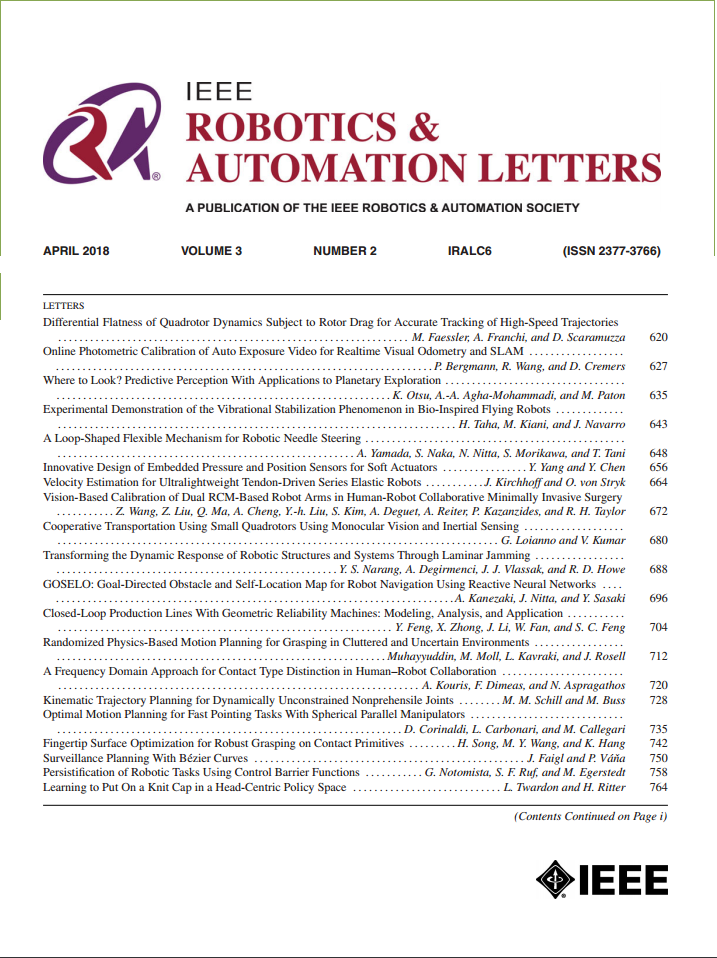Design and Control of a Tilt-Rotor Tailsitter Aircraft With Pivoting VTOL Capability
IF 4.6
2区 计算机科学
Q2 ROBOTICS
引用次数: 0
Abstract
Tailsitter aircraft attract considerable interest due to their capabilities of both agile hover and high speed forward flight. However, traditional tailsitters that use aerodynamic control surfaces face the challenge of limited control effectiveness and associated actuator saturation during vertical flight and transitions. Conversely, tailsitters relying solely on tilting rotors have the drawback of insufficient roll control authority in forward flight. This letter proposes a tilt-rotor tailsitter aircraft with both elevons and tilting rotors as a promising solution. By implementing a cascaded weighted least squares (WLS) based incremental nonlinear dynamic inversion (INDI) controller, the drone successfully achieved autonomous waypoint tracking in outdoor experiments at a cruise airspeed of 16 m/s, including transitions between forward flight and hover without actuator saturation. Wind tunnel experiments confirm improved roll control compared to tilt-rotor-only configurations, while comparative outdoor flight tests highlight the vehicle's superior control over elevon-only designs during critical phases such as vertical descent and transitions. Finally, we also show that the tilt-rotors allow for an autonomous takeoff and landing with a unique pivoting capability that demonstrates stability and robustness under wind disturbances.具有旋转垂直起降能力的倾转旋翼机设计与控制
尾坐飞机由于其灵活悬停和高速向前飞行的能力而引起了人们的极大兴趣。然而,在垂直飞行和过渡过程中,使用气动控制面的传统尾座椅面临着控制效率有限和相关致动器饱和的挑战。相反,仅依靠倾转旋翼的后倾式飞机在前飞时的滚转控制权限不足。这封信提出了一个倾斜旋翼飞机与升降副翼和倾斜旋翼作为一个有希望的解决方案。通过实现基于级联加权最小二乘(WLS)的增量式非线性动态反演(INDI)控制器,无人机成功实现了16 m/s巡航空速下的自主航点跟踪,包括前飞和悬停之间的切换,且无执行器饱和。风洞实验证实,与纯倾斜旋翼相比,该机型的滚转控制性能得到了改善,而对比室外飞行测试则强调,在垂直下降和过渡等关键阶段,该机型的控制性能优于纯升降翼。最后,我们还表明倾斜旋翼允许自主起飞和着陆,具有独特的旋转能力,在风干扰下表现出稳定性和鲁棒性。
本文章由计算机程序翻译,如有差异,请以英文原文为准。
求助全文
约1分钟内获得全文
求助全文
来源期刊

IEEE Robotics and Automation Letters
Computer Science-Computer Science Applications
CiteScore
9.60
自引率
15.40%
发文量
1428
期刊介绍:
The scope of this journal is to publish peer-reviewed articles that provide a timely and concise account of innovative research ideas and application results, reporting significant theoretical findings and application case studies in areas of robotics and automation.
 求助内容:
求助内容: 应助结果提醒方式:
应助结果提醒方式:


